There are two types of product descriptions for ecommerce businesses.
Product descriptions that tell and product descriptions that sell.
Which one would you rather create? More importantly, which one would your website visitors want to see?
A great product description has the power to turn a casual shopper into a revenue-generating buyer. Yet too many online stores simply tell shoppers about the product rather than selling it to them.
There’s a big difference!
Today, I’m going to show you ten superb examples of ecommerce websites with product descriptions that sell and how you can replicate their success over and over again.
In an attempt to provide actionable advice for as many businesses as possible, I pulled examples of product descriptions from a variety of ecommerce verticals. We can all learn from each other, right?
Now, let’s dive in.
Everlane [Fashion & Accessories]
Everlane sells high-end, eco-conscious fashion and accessories for men and women. Their product descriptions match their style: sassy, yet classy.
Here’s a look at The Day Heel that retails for $145 online:[*]
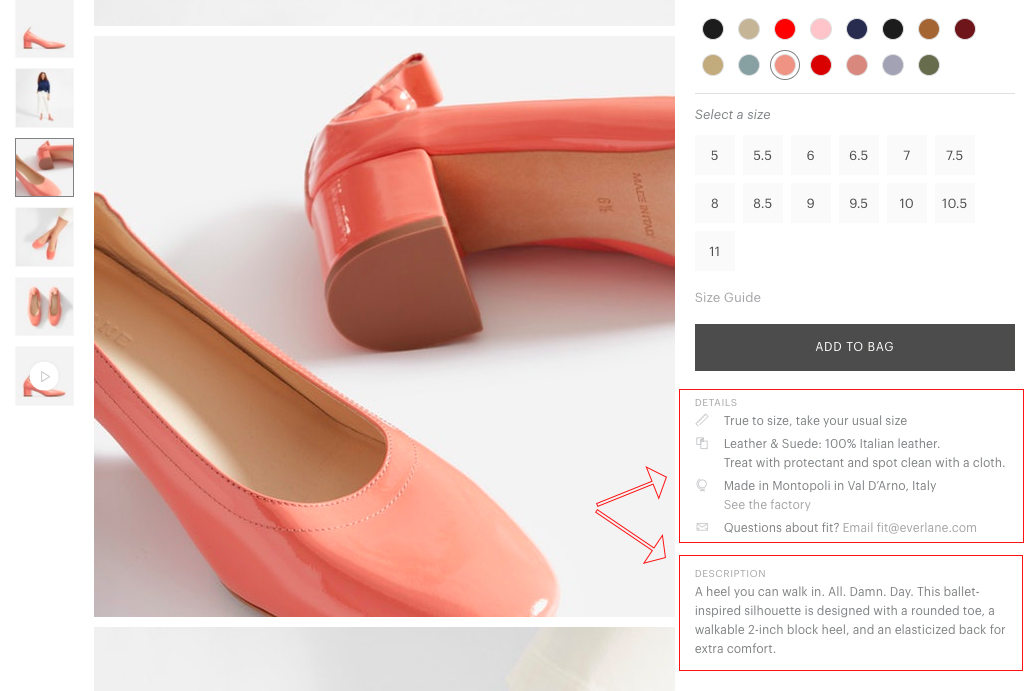
What I love about Everlane and the way they approach describing this heel (and other products) is that they speak in the language of their customers.
Using phrases like “All. Damn. Day.” and “take your usual size” makes shoppers feel as if they were talking to their friends, not a business.
Key Takeaway: Write product descriptions in the natural language of your target customer. the language your customers use in their reviews, either on your site or on sites like Amazon. Lean on your support team and pull language from the actual questions customers ask. Or head to Quora and look at the language people use when talking about similar products. Approaching your description with this mindset will make your product naturally appeal to your customer.
Patagonia [Outdoor Gear]
It’s no accident that Patagonia finds themselves on a list like this.
They’ve spent years crafting and perfecting their well-known brand, and every single product description is an extension of that.
Let’s pick a product, any product. This Linked Pack 28L will do:[*]
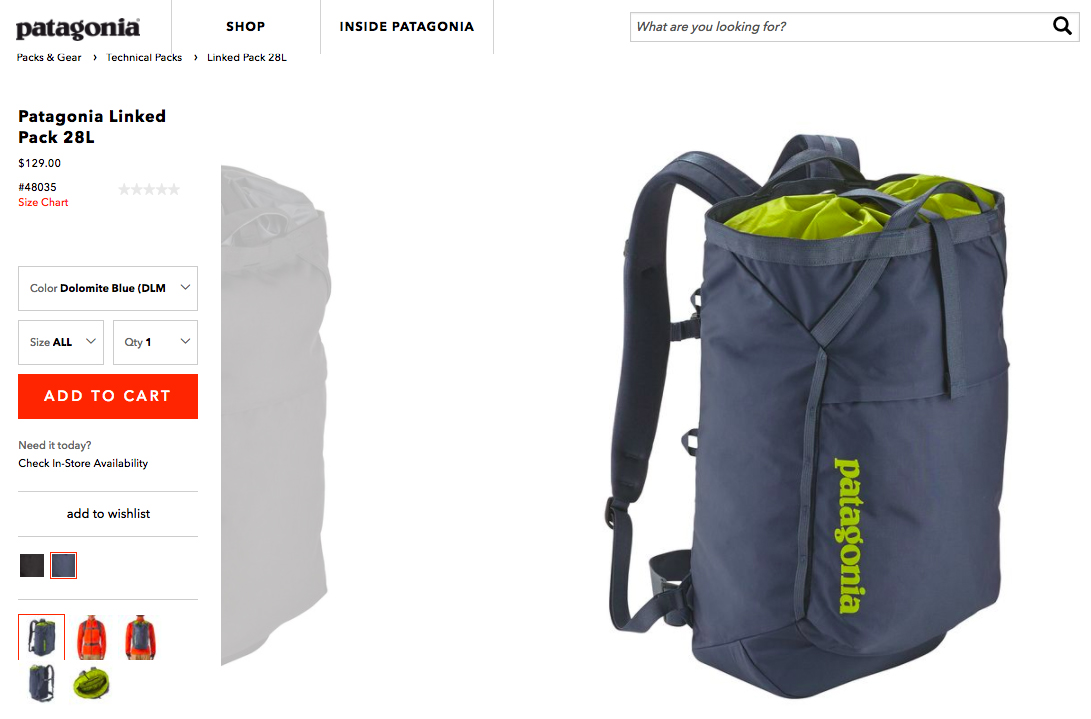
The product description was so detailed, I had to get a close-up with a second screenshot:
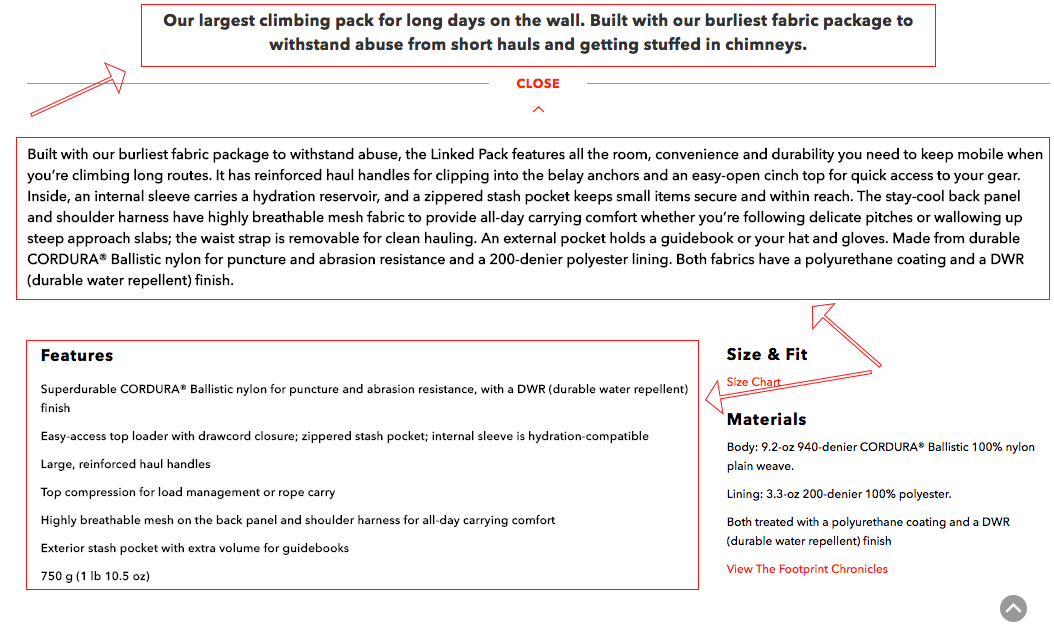
One major component that makes Patagonia’s product descriptions so compelling is that they’re not afraid to speak in outdoor industry jargon.
Many ecommerce businesses shy away from using technical jargon on pages because it might “scare off some customers.” But, for companies like Patagonia in a niche industry, it can lead to the exact opposite by attracting customers.
Key Takeaway: Using phrases like “burliest” and “long days on the wall” allow Patagonia to demonstrate that their employees (as well as the Patagonia brand as a whole) understand the little nuances of each product and how it’s used in the real world. That helps to build trust with the hardcore outdoor shoppers who are most likely to buy their products and advocate for their brands.
DeWalt [Hardware, Tools, & Accessories]
Often the art of writing a great product description that sells the product lies in the ability to describe the little things that make all the difference.
The little differences and features in a product that may seem trivial or boring to you are important to shoppers and help them make purchase decisions.
DeWalt, the creator of the 14 oz Mig Weld Framing Hammer, does just that.[*]
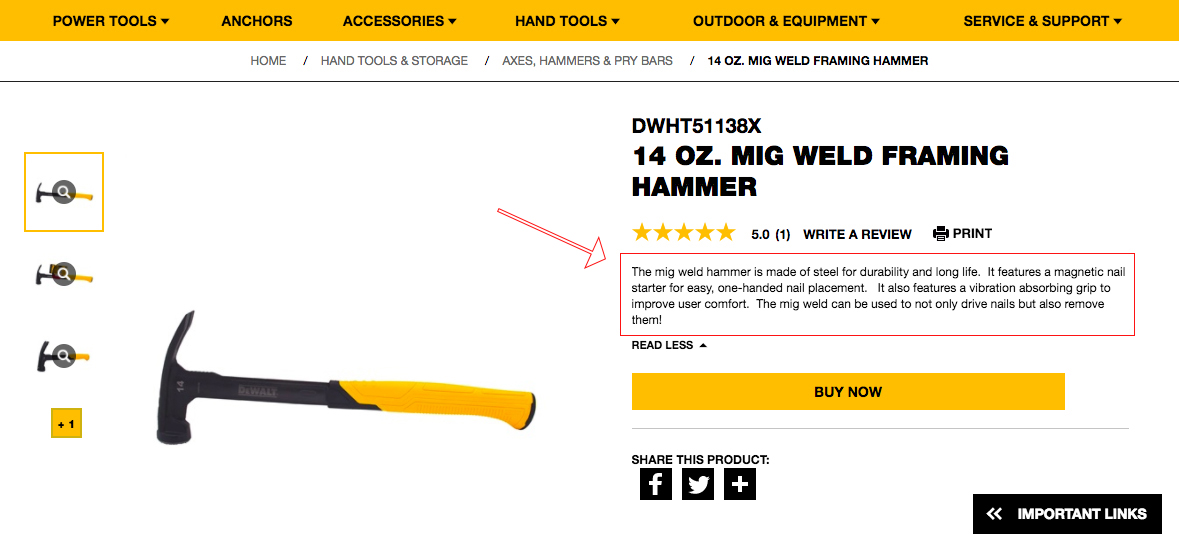
Remember, it’s a hammer. But this isn’t just any hammer!
This hammer features a “vibration absorbing grip to improve user comfort” and is a light 14oz “for a fast swing and reduced fatigue.”
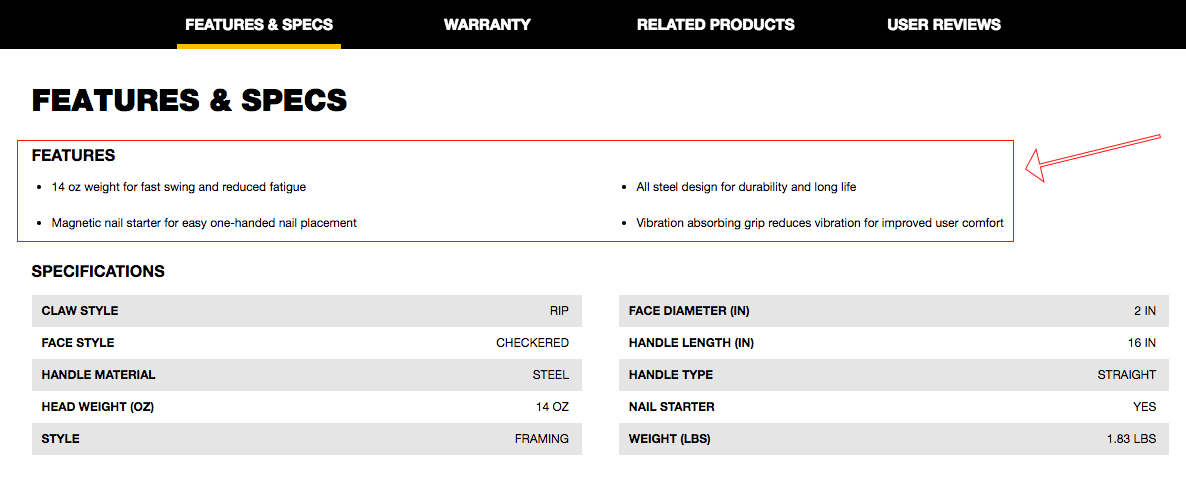
To find out exactly which features are most important to your customers, start with the product’s reviews:
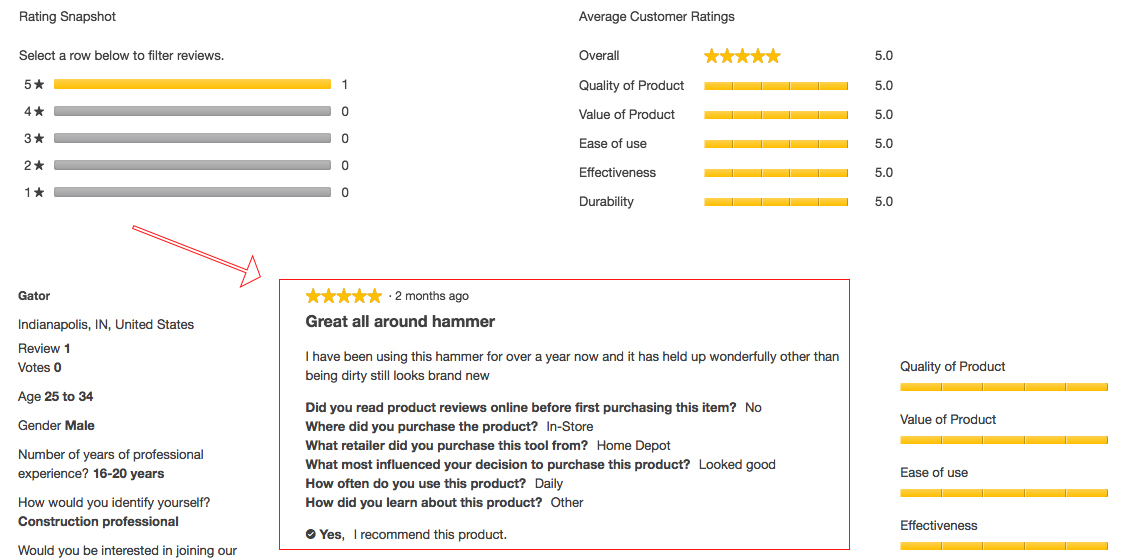
In the example above, the customer cares about the hammer looking new, even after repeated use—a great idea to include in future iterations of the product description.
Key Takeaway: You’re not competing against every product online. You’re competing against similar products in your industry. A hammer vs. hammer, for example. And while there’s a lot that goes into the buying decision process, one of the biggest reasons why shoppers buy your product over others is how you choose to describe it. Describe the little features. Talk about the nuances. Nothing is too insignificant or trivial!
AppSumo [Online Courses]
Not every ecommerce product is a physical one, yet it still takes the same wordsmith finesse to sell a service.
AppSumo’s Make Your First Dollar online course is a prime example of the persuasive power of what I like to call the “ideal you.”

Many of us want to be successful, make a ton of money, live a good life, and be a good person.
The “ideal you” product description plays right into that natural human drive. You can get a template to apply the “ideal you” product description in your business by clicking on the button below.
Get My "Ideal You" Product Description Template
This technique takes the shopper (metaphorically) on a journey from where they are now to where they want to be in the future.
Notice how AppSumo asks very specific and strategic questions:
Have you failed at starting a business?
Have you failed at trying?
What business do you want to start?
Then, once you’ve internally answered “yes” to one or more of these questions, you’re presented with four case-studies of successful entrepreneurs that have been in your shoes before.
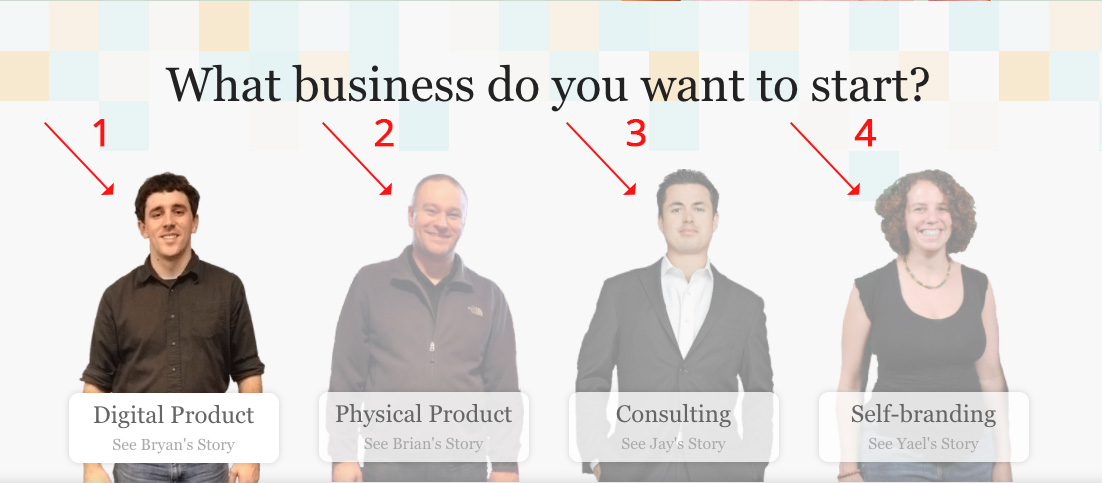
All of whom have taken AppSumo’s course!
Key Takeaway: Why do people shop? People shop because they’re looking for solutions to their problems. They need something to improve their lives that they couldn’t otherwise do or achieve without your product. Show people the ideal versions of themselves. Use product descriptions to paint a before-and-after picture. To see the copywriting formula AppSumo uses to write product descriptions that make $250,000+ in 7-10 days, read this.
Dollar Shave Club [Beauty & Grooming]
Ever wonder why so many brands use humor on their websites, in their content, in their product descriptions, and in their advertisements?
Simple.
Humorous material tends to be recalled at higher rates than non-humorous material. It’s also been shown to break down people’s resistance to being influenced by advertisements.[*]
Dollar Shave Club has been using humor to sell razors for years. Their 2012 commercial has now been viewed more than 25 million times on YouTube alone:
The same humor that drove that video to success also drives sales on their website. Each product description is a small extension of the Dollar Shave Club brand, even if it’s out of this world (pun intended).
In this example they use the clever saying of “the final frontier” to insinuate that it’s the only razor you’ll ever need and then drum up a hilarious visual with the line “like a personal assistant for your face”:

They stick to what makes them them, even if there’s important information to get across in the product description:

Many ecommerce businesses would be happy with the standard “not tested on animals” line. Not Dollar Shave Club. “Tested on interns, not animals” is much more on-brand and memorable.
Key Takeaway: Humor is a powerful tool to not only help people remember your product over your competitors’ product but also to make influencing their purchase decision easier. However, humor is a tricky thing to balance in product descriptions. Too much humor and you’ll come across as abrasive; too little humor and it won’t have the effect that you want. Learn from those that do humor right like Dollar Shave Club.
Subaru [Autos, a.k.a. Big-Ticket Items]
Selling an item where the price point is in the tens of thousands of dollars takes a product description that is more than just a clever sentence or two.
Selling something like a car, for example, requires a full understanding of your ideal customers’ psychographics. You need to speak to their deepest fears, pain points, and desires.
Their new Subaru Ascent’s product page is handcrafted for their ideal customer: families.[*]
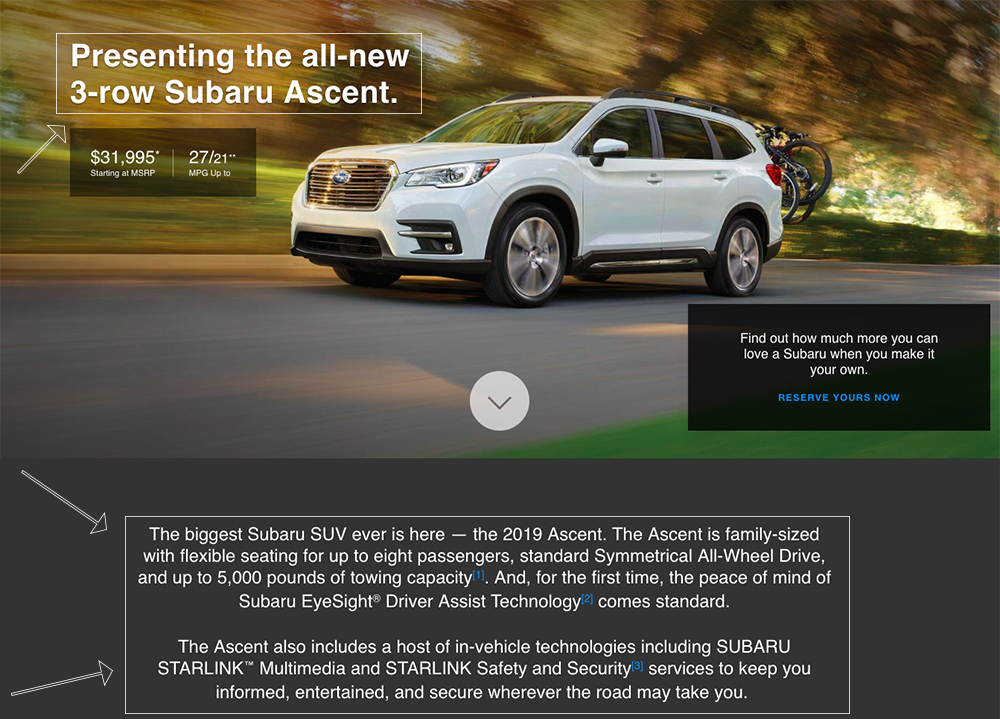
Notice how many times they talk about “security” and “spaciousness”—two pain points faced by all families. They’re not done there, however:
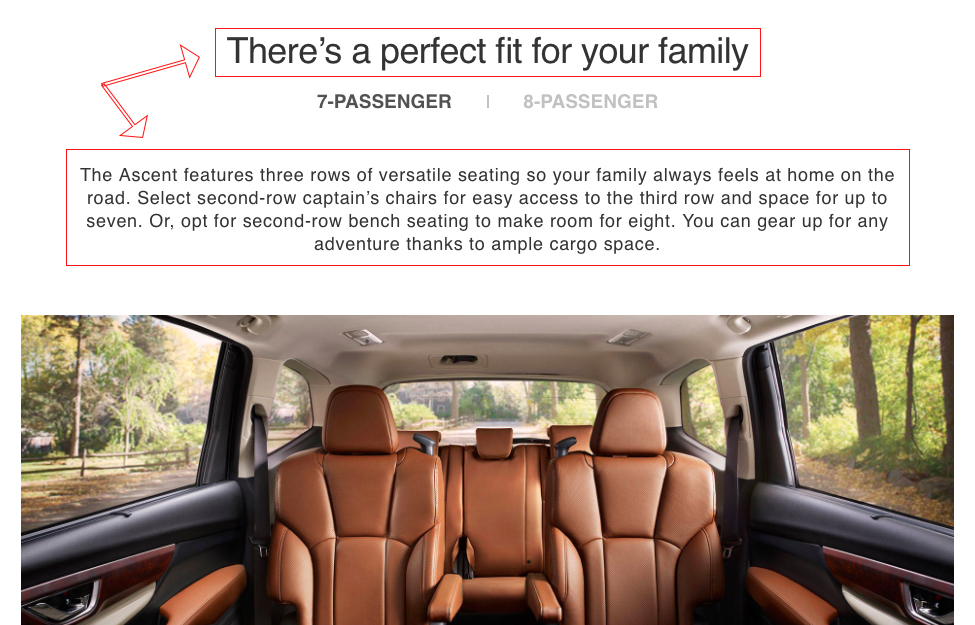
If you still aren’t convinced that this car is perfect for families, they have more to tell (or should I say “sell”), complete with a photo of the product’s spaciousness to match.
Now you’re convinced.
But what about the longevity of the vehicle? Buying something this expensive is a big decision!
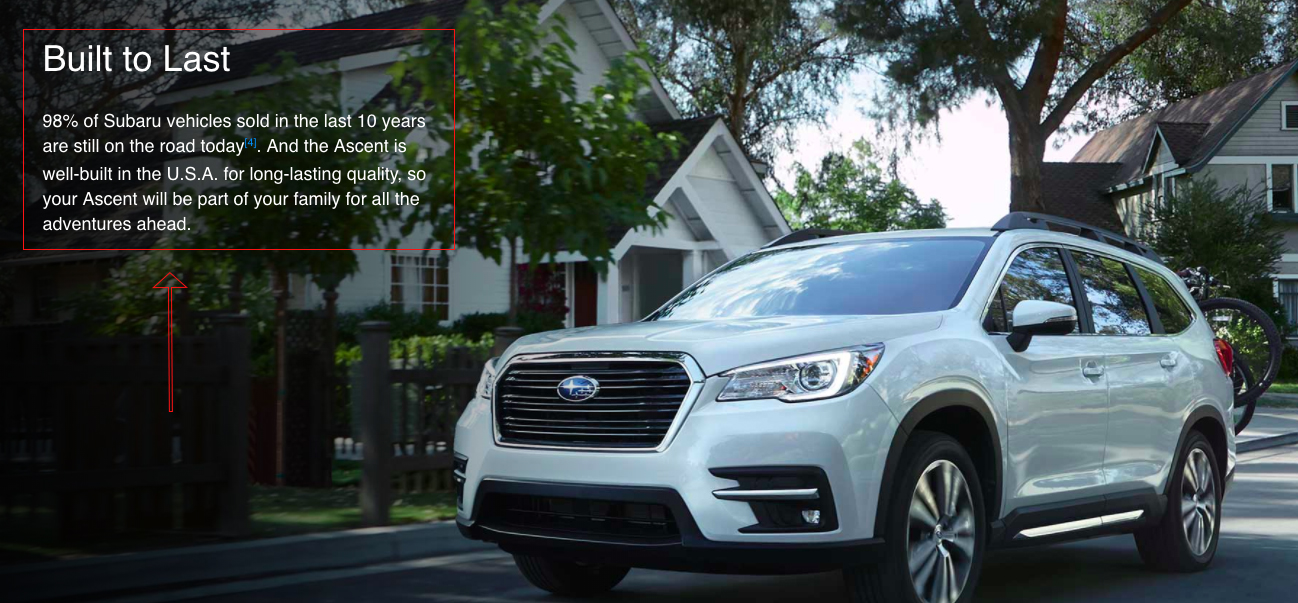
Don’t worry. Subaru has you covered there as well. Take note of the data points here—when it comes to technical aspects of the product, you don’t want to take any chances.
There’s only one element missing from this product description.
Testimonials and product reviews can increase conversion on your sales pages by 34%, making them crucial for big-ticket items. In this case, Subaru uses testimonials to increase completions of their lead generation form.[*]
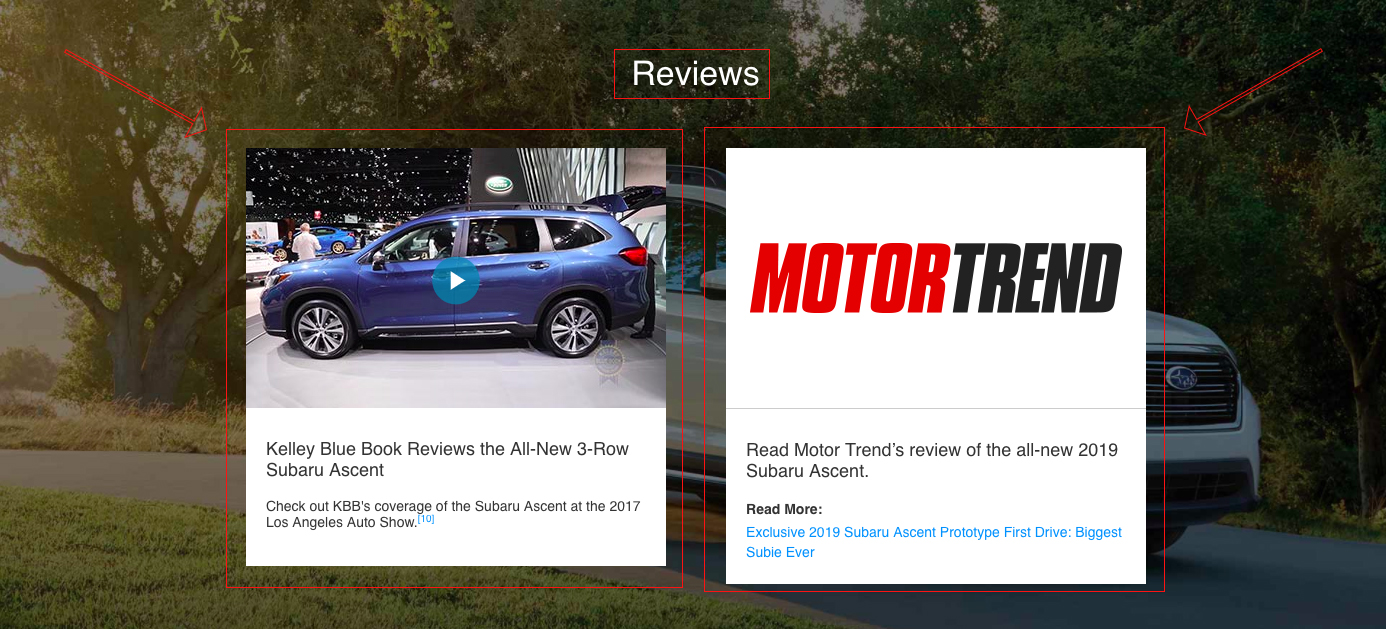
Subaru doesn’t just get any product reviews; they get two from extremely reputable sources: Kelley Blue Book and Motor Trend.
But there’s another type of ideal Subaru shopper that their team has discovered over the years—sparking a new wave of creative product campaigns… Dog lovers.[*]
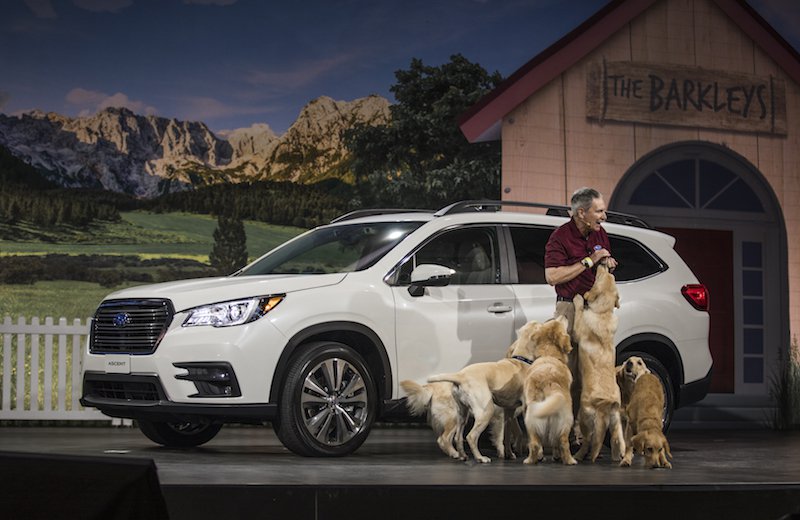
Senior Vice President of Marketing at Subaru, Alan Bethke, sums the importance of identifying your ideal customer(s) when he says, “We identified dogs as the common truth that made these owners the same.”
Now I recognize Subaru isn't going to have an "order now" button (it's not a traditional ecommerce site), but the first place buyers go when researching a car is online and so a great product description will make a lasting impression.
Key Takeaway: If the main source of income for your business is big-ticket items, you need to focus on a robust set of product descriptions that solve your potential and ideal customers’ biggest pain points. First, address head-on what they’re looking for most in a product similar to yours. Then, address pain points that your product solves better than your competitors.
Shopify [Software as a Service/SaaS]
In terms of ecommerce brands, Shopify is on top of the world.
They recently went from $205.2M to $389.3M revenue in just 365 days and are the third most visited website in the world in the “Business Services” category.
So why do more than 500,000 merchants use Shopify to power their online stores?
One, because it’s a killer product. And two, because the Shopify team has their messaging and product description down to a science.
It’s all about an emotional connection:[*]

Shopify knows that a majority of their merchants are small business owners. Those merchants want to know they’re making the right decision.
I particularly love the use of the line “or out of the trunk of your car” here, as that is highly emotional for lots of entrepreneurs.
As is the feeling of being overwhelmed. Shopify has that covered as well:
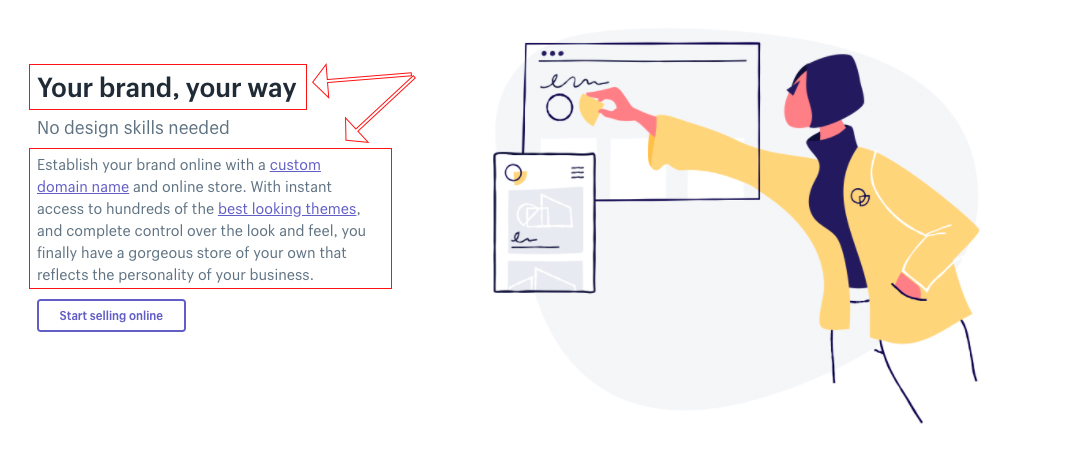
Notice the line “no design skills needed.” This helps to immediately calm any fears business owners might have about creating a website.
Key Takeaway: Starting a business is an extremely emotional roller coaster. You as a business owner are often putting your life savings and work into a new venture—which can take a toll. Whether you’re a SaaS company or something else entirely, it’s important to try to establish a strong emotional connection between your customer and your product descriptions. Show shoppers know that you know what they’re going through. Describe how you’ve been in their shoes and how your product or service is the perfect solution to their already hectic lives.
Google Home [Electronics]
Sometimes the best solution for writing product descriptions that sell is to just keep it simple.
Unlike products such as the DeWalt hammer above that require lots of tiny details, items that are particularly unique, growing in popularity, or high in demand don’t need all the extra wording.
Google, the creator of the Google Home, is the master of brevity.[*]
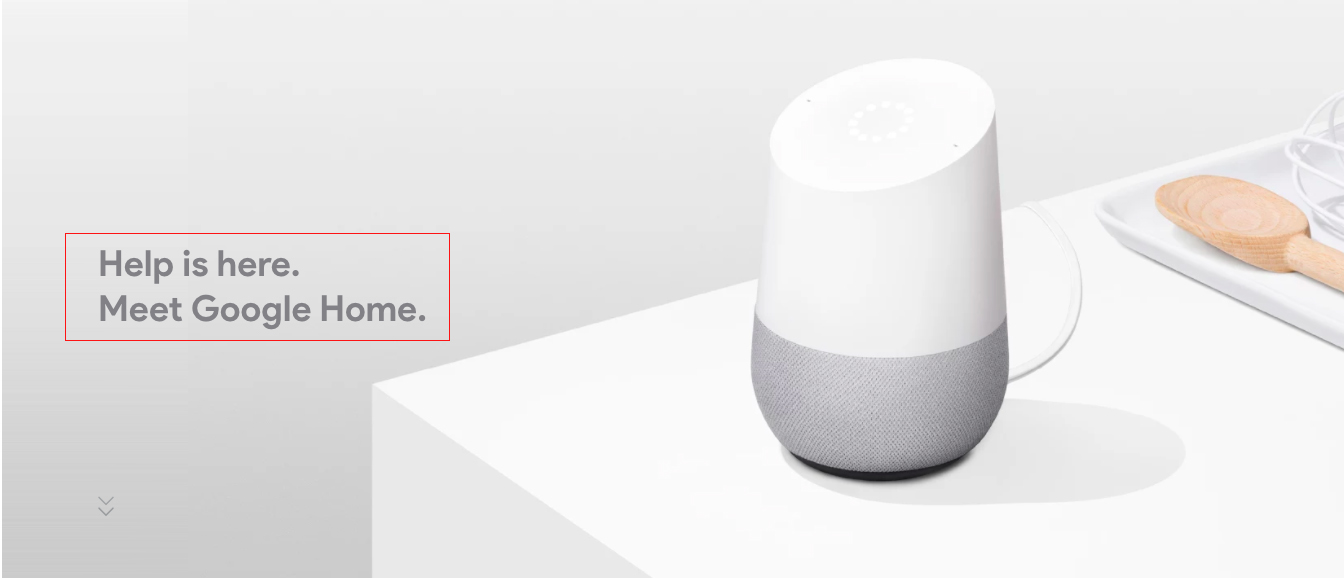
When you’re lucky enough to have a product that practically sells itself, the last thing you want to do is talk a shopper out of it.
Hone your messaging by utilizing just a few words. In each section of the Google Home product page, for example, features are described in a creative 5-10 words:
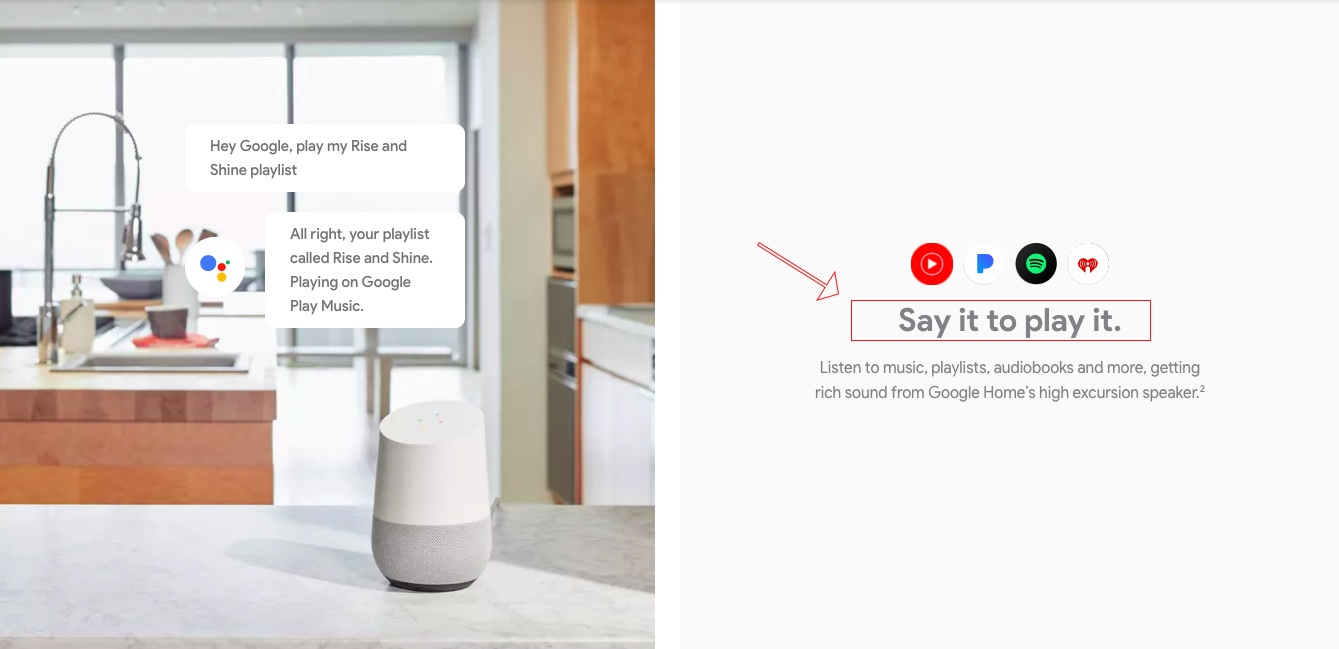
Try techniques like rhyming words or coming up with your own unique one-liners to help set your short descriptions apart and give them personality. “Say it to play it” used here by Google is a great example.
Key Takeaway: The art of brevity is a magical thing when it comes to product descriptions. Being able to describe your product in just a few words helps to reduce confusion among your buyers and increase sales to your business. If you’re wondering how to hone your message, I recommend writing as you normally would. Then, remove the extra words that aren’t needed. Do it again. And again until you have a finely-tuned description that is fewer than 10 words.
Wayfair [Furniture & Home Goods]
Wayfair is one of the largest online-only home goods retailers in the world, with over 3,800 employees and 36 million active customers.
Part of what makes them so successful is their ability to spark imaginations through storytelling—making customers feel what it might be like to have the product in their home.
Take this hanging light, for example:[*]
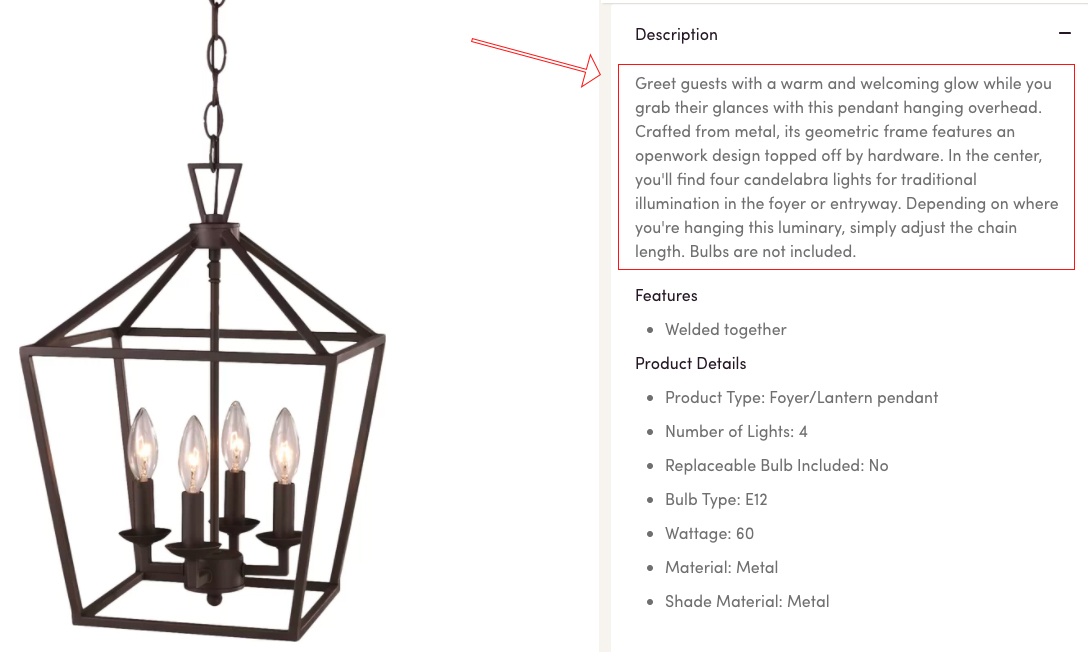
They could have gone with the standard generic description of the light and its features. Instead, they start with, “Greet guests with a warm and welcoming glow.”
I don’t know about you, but that immediately makes me imagine hosting a party and this beautiful light hanging above.
Or how about this Kennedy Barrel Chair:[*]
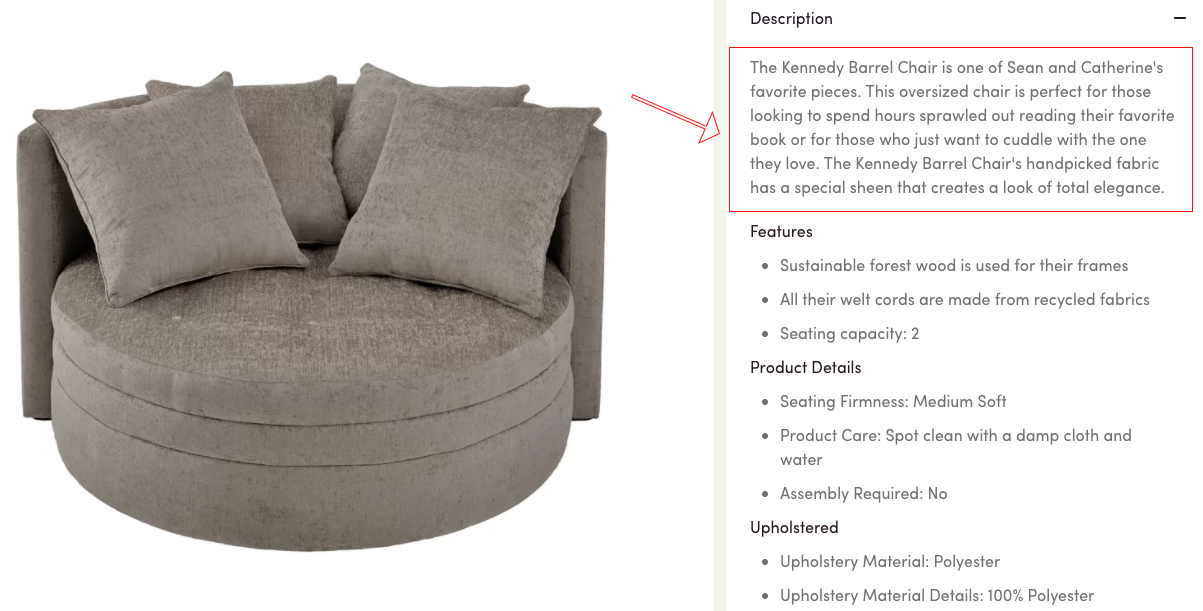
Again, forget the generic product descriptions shoppers are used to seeing. “Perfect for those who just want to cuddle up with the one they love.”
Immediately, I’m imagining a lazy Sunday with my wife. Where’s the buy button?
If you’re unsure which words to use when coming up with imaginative descriptions, check out our list of power words that will have your products flying off the shelf while your competition falls flat (pro tip: download the one-page pdf of 401+ power words and stick it up on your wall for inspiration).
Key Takeaway: ecommerce is a tricky business because potential customers can’t actually touch your product before they buy it. It’s up to you to get their imagination running wild with all the possibilities of what your product will look like and how it will make them feel. Often that means telling a story. As the great writer and journalist Joan Didion once said, “We tell ourselves stories in order to live.” Or in this case, we tell ourselves stories in order to buy.
Malicious Women Candle Co. [Candles]
Candles come in all shapes, sizes, smells, colors, and cases.
But candles that are “infused with sass”? Now those are candles that I want to support - even if just for the novelty of the product.
Malicious Candle Co. and their “Sending Thoughts and Prayers - Infused With ‘Absolutely No Effort’” candle is a perfect example of how sarcasm can help sell products with a little bit of attitude (or a lot of attitude—but you’ll need to browse the site to find those product descriptions yourself).
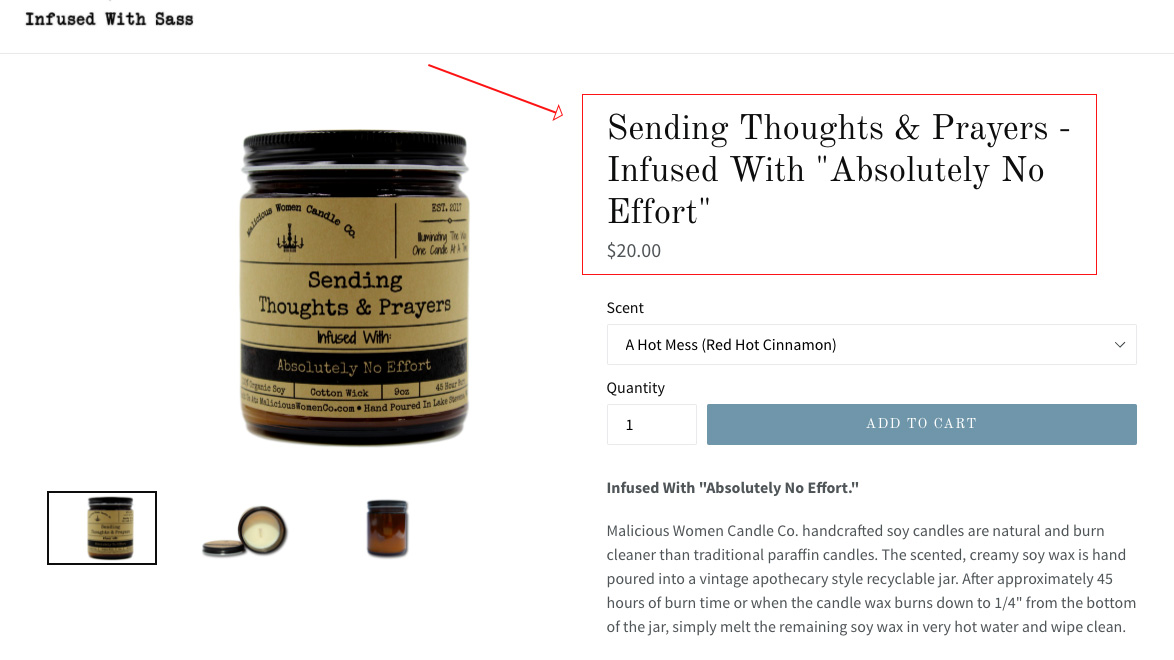
The first thing you see on the page is a non-traditional product name. Immediately you know this isn’t any ordinary candle.
In this example, Malicious Women Candle Co. perfectly captures the spirit of how shallow a candle gift can come across. They beat you to the point and take away the shallowness with sarcasm—almost poking fun at themselves.
And then there’s my personal favorite candle, “Fresh Moving Boxes - Infused with "30 Years Of Debt":
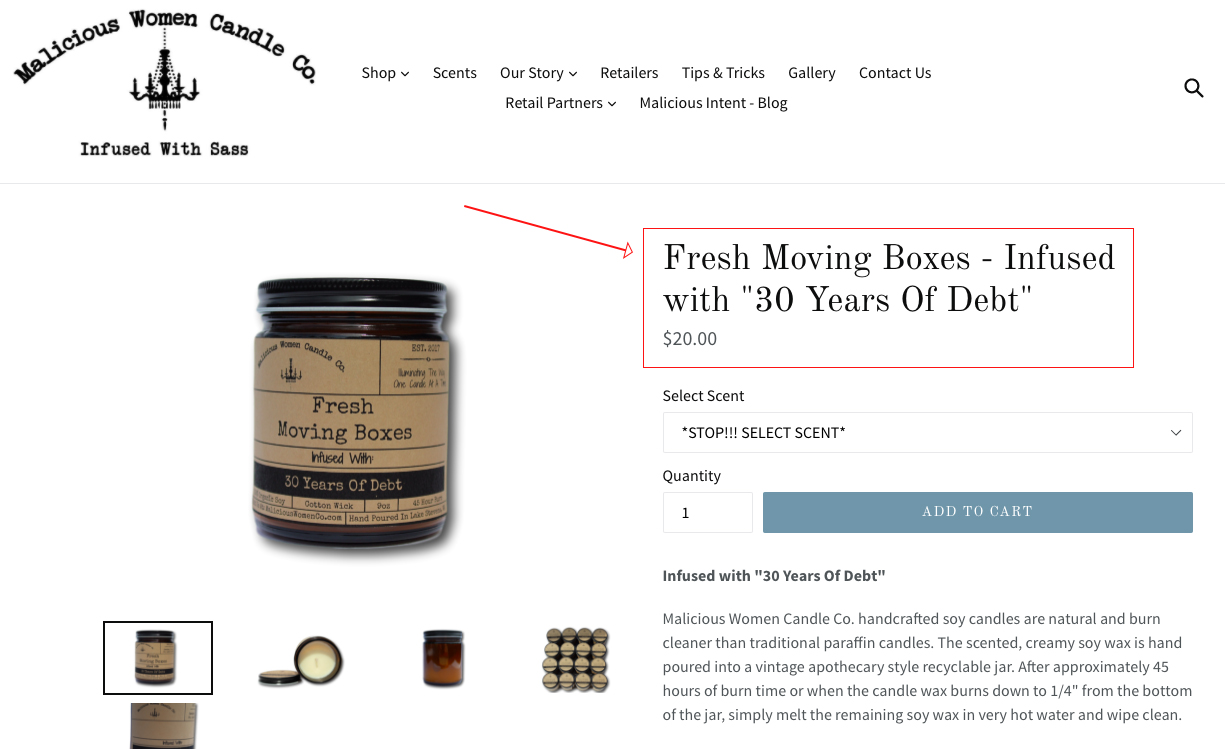
What better way to welcome a close friend or family member into their new home with a great smelling candle, oh, and 30 years of debt?
Malicious Women Candle Co. finds the perfect balance between “gag gift” and thoughtful sarcasm—making them an excellent inspiration for your products.
Key Takeaway: Not all product descriptions are created equal, though lots of product descriptions are created the same. Same copy, same format, same style. But every once in a while you stumble across something special, something that speaks to you. We all have a little “sass” inside of us and sarcasm is the perfect way to bring that sass out. In other words, write product descriptions that people wish they could say, but are too afraid to. That’s the beauty of sarcasm and it can help you sell products.
What We’ve Learned
Writing great product descriptions takes work. One way to get really good, really fast, is to try several things until you find something that truly works for you and your business.
Upworthy shared several of what I think are some of the finest tips on the editorial process, including these two which apply directly to writing product descriptions:[*]
You HAVE to crap out 25 headlines for every piece of content (i.e., write 25 descriptions for every product until you find the right one)
Once you start getting desperate, you start thinking outside the box (i.e., your first attempt at a description will not be your best. Get desperate)
Whether you’re sparking a shopper's imagination with a good story or speaking in their natural language, every ecommerce business will have something that makes them them.
Now go out and find it! Or use this fill-in-the-blank template to help with three of my favorite ecommerce product description templates that you can use over and over again to create copy that customers will love.
Get My Fill-In-The-Blank Ecommerce Product Description Template

Comments